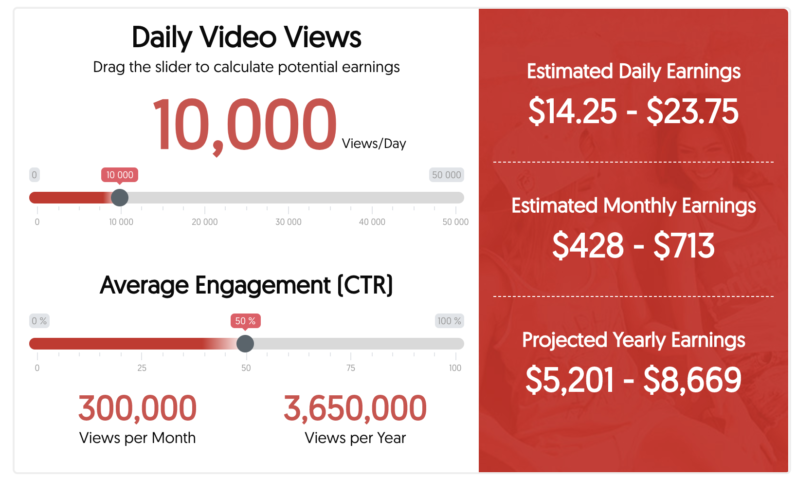The Brief: We cover 10 jobs that were obscure or nonexistent 10 years ago and how people actually make a living from them.
DEEP DIVE
Even 10 years ago, most people might have never guessed that there’d be full-time podcasters or Twitch streamers. Yet in 2019, content creators like Ninja and the Kardashians can pull in millions of dollars just by playing video games or posting sponsored grams. While these jobs aren’t always easy work or lucrative for the average person, it’s still pretty mind-blowing that titles like ‘budtender’ or ‘social media influencer’ are a real thing.
1. Instagram Influencer
A picture may be worth a thousand words, but a sponsored post by a popular Instagram influencer can nab up to $3000. Instagram launched in 2010, and now, brands can offer $5-$10 CPM (or the cost to reach a thousand people), and so a mid-level influencer with 300,000 followers can earn between $1500 and $3000 to promote everything from fashion brands to skincare products. And the influencer title isn’t limited to established stars like the Kardashians who can earn up to $1,000,000 per post — tons of fitness and lifestyle users, Instagram comedians, beauty gurus, and others can leverage their clout to earn income.
Their influence is real too — according to a 2019 study, 81 percent of Americans have said they made a purchase through a post an influencer shared. But some social media stars have been criticized for slinging unhealthy products like weight-loss teas and photoshopping their pictures, and thereby giving their often young followers unhealthy notions about body image.
2. Weed Dispensary Consultant (Budtender)
Currently, recreational marijuana is legal in 10 states, as well as Washington, D.C. Since Colorado and California legalized recreational marijuana, in 2014 and 2016, respectively, the states have brought in a combined $4 billion through the industry. Weed pens, weed delivery services (one of whom Snoop Dogg has backed), and dispensaries have flooded the market with more marijuana options than ever before. The rise of dispensaries has also seen the introduction of “budtenders,” marijuana consultants whose job entails answering customers questions and providing recommendations for various strains. It’s not an especially lucrative path, with the hourly wage averaging $15 in Los Angeles, but at least budtenders are helping people get lit, responsibly.
3. Gamer/Livestreamer
In 1958, a simplistic game called Tennis for Two debuted, becoming the world’s first video game. Fast forward a couple decades, and it’s estimated that 427 million people will be watching esports this year. One of the most popular esports platforms is Twitch, which has 15 million daily active users, who watch players livestream their gameplay and provide commentary. The site’s biggest streamer, Ninja, brought in $10 million from playing Fortnite in 2018, and it’s estimated that the top 10 Twitch streamers gross more than $20 million between them. Typically, top streamers can earn money through ads, sponsorships, affiliate links, subscriptions, and donations from fans. While most people won’t ascend to Ninja-like ranks, if they’re able to accumulate at least 50 followers and become Twitch Affiliates, they may be able to earn extra income on the side.
4. Sustainability Consultant
As recent events like the trashtag challenge and climate strikes have shown, more and more young people are dedicated to sustainability efforts than ever before. We’ve also seen businesses investing money into hiring sustainability managers to help with green initiatives, which can involve introducing recycling programs, improving a company’s supply chain, and creating marketing strategies. Sustainability consultants can be paid an average of $83,000 a year, so it’s a green job, indeed.
5. Soundcloud Rapper
The latest way to finesse a career in the music industry involves uploading music to Soundcloud and having it go viral. The phrase “Soundcloud rapper” connotes a specific style of rap, also known as “mumble rap” or “emo rap.” Well-known artists including Lil Peep, Lil Uzi Vert, Lil Pump, and XXXTentacion got their start on Soundcloud.
Anyone can upload to Soundcloud for free and earn money through Soundcloud’s partner program if they have enough listeners. However, serious money usually comes only to rappers who sign with major record labels. For example, Lil Pump signed a contract with Warner Bros. last year for around $8 million.
6. YouTuber
YouTube has been around since 2005, but it didn’t experience a boom until much later. Now, there are many people who have made it their full-time jobs, even without having millions of subscribers, due to many factors. First, there’s a wide variety of avenues to tap into, from big genres like tech or beauty, to super niche channels that involve cooking miniature foods or doing cosplay ASMR. Whatever you’re into, there’s probably an audience for it.

There are over 2,000 channels that have 1 million plus subscribers, and the top 10 YouTubers in 2018 all brought in at least $10 million. Beyond AdSense revenue, content creators can use sponsorships, YouTube Partnerships, and merch sales to boost their revenue. According to Influencer Marketing Hub, a channel which gets 10,000 views per day could make between $428 and $713 per month, or a few thousand dollars a year. It’s definitely not an easy gig, and an aspiring YouTuber has to put in tons of hours filming and editing, figuring out how to compete with other channels, and dealing with annoying issues like YouTube demonetization, which many popular creators have spoken out against.
7. Sneaker Reseller
Sneaker and hypebeast culture is bigger than ever before, and sneaker resellers have taken advantage of sneakerheads’ willingness to shell out thousands of dollars for the latest Jordans or Nike Off Whites. Resellers buy sneakers in bulk, camp out (or pay someone to camp out) for launches, and wait until a shoe becomes a collector’s item to sell it back for a profit. The sneaker industry has reached $55 billion heights, with a $1 billion resale market.
Many resellers flip sneakers on top of another job, and only resell sneakers than would fetch sizable profit margins. Depending on each seller’s specific business model, the margin can range from $30 to $500 per shoe, and yearly earnings go from $60,000 to $120,000. But unless you’re dedicated enough to spend hours following sneaker trends, waiting in line, and building a client base, pursuing reselling is not for the casual entrepreneur.
8. Content Moderator
With the vast amount of content proliferating the Internet, sites like YouTube and Facebook have made it a priority to hire content moderators to take down offensive material. Some companies outsource jobs to the Philippines, at paltry salaries like $500 a month. But even for well-paying gigs at Google and other prestigious companies, where $20 an hour and free lunch are among the perks, it isn’t all fun and games.
Take one Google content moderator, whose job entailed watching decapitations and suicide bombings at work. It took such a toll on his mental health, that he turned to drinking and eventually had to quit. So while content moderators might comprise “as much as half the total workforce for social media sites,” according to Wired, there are serious implications involved in the job that could dissuade people from doing it long term, and call for content moderation companies to take more action to help their employees’ mental health.
9. App Developer
The Apple App store debuted in 2008, and 10 years later, the global app revenue hit $71 billion. App developers are hugely in demand by companies, but tech-savvy people can choose work independently as well. A couple reasons someone might want to work on apps: a mobile app is a contained system, and you don’t need millions of dollars to build one. But there is a cost — $99 to sign up on Apple as a developer, plus you need to know how to write in Objective-C, a programming language. It’s not something anyone can do, but since it’s relatively low stakes, it’s easy to see why so many people want to try their hands at building the next big app. According to Glassdoor, app developers earn a national average of $76,000 a year, with $58,000 being on the lower end.
10. Podcaster
In 2018, 73 million Americans listened to podcasts monthly, and the abundance of podcasts on the market has even led to memes about the medium. Many factors have led to the boom of the podcast era: it’s relatively easy to set up mics and podcasting equipment, people can listen while in transit, there are genres ranging from true crime series to cultural commentary, and brands can insert ad reads into an episode. Sponsored episodes typically feature several short ads. Rates can range from $15 to $30 per ad for every 1,000 listeners, which means some of the top podcasters can take home thousands of dollars per episode. While the average person may not reach such heights, a podcaster can use subscription platforms like Patreon, where fans directly contribute money, to keep their project afloat.
A group of white men is called a podcast
— Bяyan (@MurderBryan) February 18, 2019
From YouTuber, to budtender, to Instagram influencer, there are so many jobs that people wouldn’t have predicted would’ve existed or flourished 10 years ago. And it doesn’t stop there — scooter charger, dog walker, and Uber Eats delivery person are all among jobs that more and more people are turning to, either as full-time or part-time gigs. Perhaps 10 years from now, TikTok Filmmaker or Chief Astrology Officer will be the hottest occupations.
